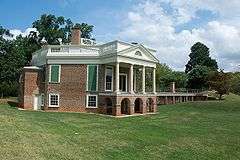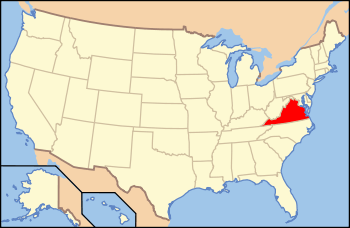Poplar Forest
|
Poplar Forest | |
|
Poplar Forest, designed by Thomas Jefferson | |
  | |
| Location | 1548 Bateman Bridge Road, Forest, Virginia[1] |
|---|---|
| Nearest city | Lynchburg, Virginia |
| Coordinates | 37°20′53.736″N 79°15′53.8194″W / 37.34826000°N 79.264949833°WCoordinates: 37°20′53.736″N 79°15′53.8194″W / 37.34826000°N 79.264949833°W |
| Built | 1806-1826 |
| Architect | Jefferson,Thomas |
| Architectural style | Other |
| NRHP Reference # | 69000223 |
| VLR # | 009-0027 |
| Significant dates | |
| Added to NRHP | November 12, 1969[2] |
| Designated NHL | November 11, 1971[3] |
| Designated VLR | May 13, 1969[4] |
Poplar Forest was Thomas Jefferson's plantation and plantation house in what is now Forest, Bedford County, Virginia, near Lynchburg. He designed it and treated it as a private retreat, working on it from 1806 until his death 20 years later. Jefferson once wrote a correspondent saying "It is the most valuable of my possessions." Skilled slave-labor was used in its construction.
Known as the architect of such buildings as Monticello, the University of Virginia, and the Virginia State Capitol, Jefferson built the more remote and lesser-known Poplar Forest as a place to escape the hordes of visitors at Monticello and seek the "solitude of a hermit." It was designated a National Historic Landmark in 1970.[3][5] It is operated as an historic house museum by the Corporation for Jefferson's Poplar Forest.[6]
History
In 1773 Jefferson inherited the estate of 4,800 acres (1,900 ha) from his father-in-law, John Wayles. He supervised the laying of the foundations for a new octagonal house in 1806, when President. This octagon house, built in accordance with Palladian principles, includes a central cube room, 20 feet (6.1 m) on a side, porticos to the north and south, and a service wing (to the east).
Although he had intended it for his youngest daughter Mary Jefferson Eppes and her family, she died at age 26. He entrusted it to her only surviving son Francis W. Eppes, upon his marriage. Eppes and his bride lived there only a short time and sold the plantation (1828) before moving to Florida.
Preservation
By different owners, the house underwent many alterations, and the plantation's area was incrementally reduced to 50 acres (20 ha) at the time of acquisition by the Corporation. The house is in part now surrounded by suburban subdivisions.
Since 1986, the restoration has been conducted through distinct phases, all in an effort for its return to during Jefferson's time: emergency stabilization of the building in 1986; research and study of what is to be restored; and then the restoration. Both exterior and interior restoration has taken place simultaneously with exterior restoration of the house and East Wing (demolished, 1840) completed (2009). The plan for interior restoration is being done according to the finishing in which Jefferson had it originally constructed up to the time of his death.
By 2014, over 600 acres (240 ha) of the original plantation has been purchased to provide a landscape easement for the house from further subdivision encroachment. Bob Vila's A&E Network production, Guide to Historic Homes of America (1996) featured the site,[7] and select portions are being left at various states of restoration in order to exhibit the condition and techniques used at the time of Jefferson. The restoration has been an opportunity for the training of people in the then-era construction techniques.
Archaeological studies have always been part of the restoration evaluation process, including the ornamental landscape. Of particular benefit, the archaeological activities have revealed artifacts of the enslaved African-American community, as well as the broader agricultural landscape that characterized the property through the American Civil War.
Its tours form part of the school student curriculum for state/local history for that part of the educational process that is usually included in American schools.[1]
See also
- Jeffersonian architecture
- List of National Historic Landmarks in Virginia
- National Register of Historic Places listings in Bedford County, Virginia
References
- 1 2 "Thomas Jefferson's Poplar Forest: Map and Directions". webpage. Corporation for Jefferson's Poplar Forest. Archived from the original on 2008-06-08. Retrieved 2008-06-23.
- ↑ National Park Service (2007-01-23). "National Register Information System". National Register of Historic Places. National Park Service.
- 1 2 "Poplar Forest". National Historic Landmark summary listing. National Park Service. Retrieved 2008-06-11.
- ↑ "Virginia Landmarks Register". Virginia Department of Historic Resources. Retrieved 2013-05-12.
- ↑ Staff, Virginia Historic Landmarks Commission James W. Moody, Jr., Director (June 2, 1969). "National Register of Historic Places Inventory-Nomination: Poplar Foresta" (PDF). National Park Service. Retrieved 2009-06-22. and Accompanying six photos, exterior, from 1964, 1971, and undated (1.27 MB)
- ↑ http://www.poplarforest.org/main
- ↑ Bob Vila (1996). "Guide to Historic Homes of America.". A&E Network.
External links
| Wikimedia Commons has media related to Poplar Forest. |
- Poplar Forest, State Route 661, Forest, Bedford County, VA: 75 photos, 10 color transparencies, 22 measured drawings, 6 data pages, and 6 photo caption pages at Historic American Buildings Survey
- "Thomas Jefferson's Poplar Forest", website of the Corporation for Jefferson's Poplar Forest
- Thomas Jefferson's architecture, University of Virginia


